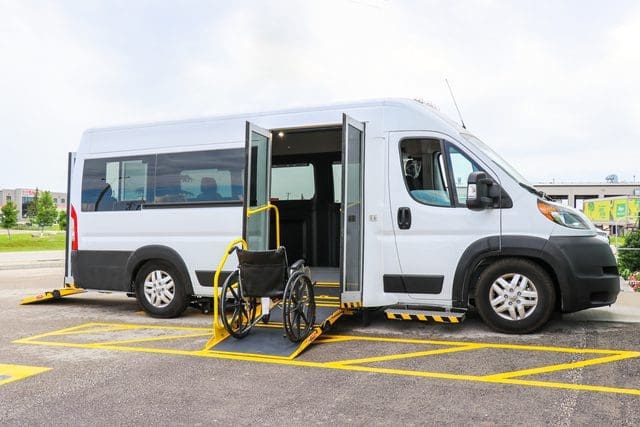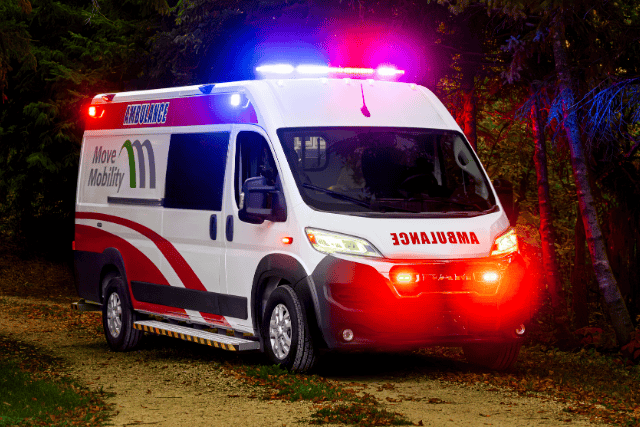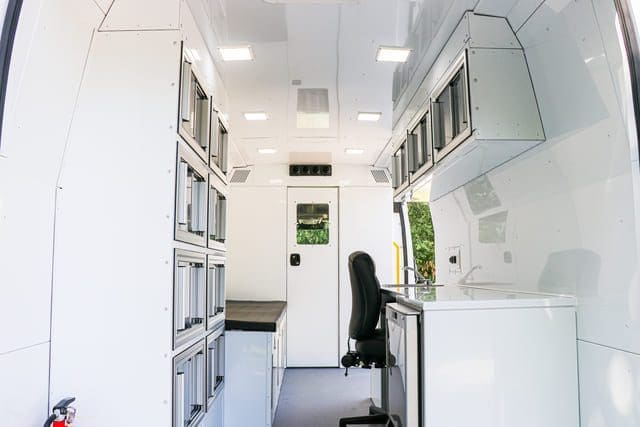Having trouble deciding between a rear-wheel drive wheelchair van or a front-wheel drive van for your program in Canada? You’re choosing for people, not parts. In 2017, nearly 30% of collisions in Canada happened on wet, snowy, or icy roads. Icy hills in North Shore BC, drifting snow in Manitoba, slush in the GTA.
The wrong choice could lead to trips getting cancelled, care being delayed, and staff burnout. Families start to worry, and riders begin to lose trust. The goal is simple. Safe, calm trips in a wheelchair accessible van that fits your routes and seasons. Close the gap, and your team serves more people with less stress.
For over 20 years, MoveMobility has built accessible vehicles across Canada, including 150+ mobile medical units. Our vehicles carry Ford QVM, Stellantis QPro, and the National Safety Mark. Teams like Keewatinohk Inniniw Minoayawin have trusted us to help them remove barriers to care. We listen first and build second, since no two communities are the same. We aim to give you a fair comparison because we know you have choices.
This guide will help you answer the big question: Which drivetrain is better for your wheelchair van program? By the end, you’ll know how each option handles Canadian weather, boarding comfort, tight urban spaces, towing, and maintenance, and which one makes sense for your routes.
What are the differences between front vs. rear wheel drive wheelchair vans?
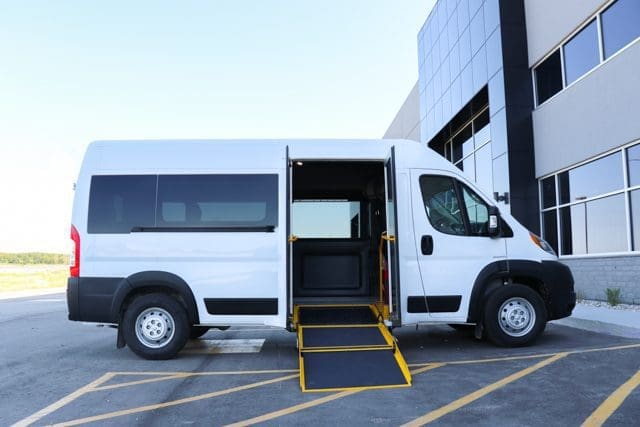
Choosing between a front and rear wheel drive wheelchair van often comes with many questions. Let’s take a look at how they compare to each other.
How power gets to the pavement
Rear-wheel drive pushes from the back. Front-wheel drive pulls from the front, with the engine weight over those tires. That weight gives front-drive vans a big boost when roads are slick.
If winter traction matters more than towing to you and your clients, front-wheel drive is usually the safer bet.
Traction and winter performance in Canada
Most Canadian programs choose front-wheel drive because it handles slush and light snow better. With winter tires, stopping can improve by 30%. For fleets in Winnipeg, Halifax, or the Lower Mainland, front-wheel drive is the more dependable option.
Quick winter tips:
- Tires: Use true winter tires as soon as temperatures drop.
- Weight: Keep essential gear near the driven axle.
- Training: Practice gentle throttle and smooth braking in a safe lot.
Choose front-wheel drive for daily urban routes in winter conditions. Rear-wheel drive can lag in traction unless it’s carrying heavy loads.
Floor height, ramp angle, and boarding comfort
Front-wheel drive vans often have lower floors. That means shorter ramps, less pushing effort, and safer boarding for riders using mobility devices.
If rider dignity and staff effort are top priorities, front-wheel drive has the edge here.
Maneuverability in tight Canadian spaces
Urban drop-offs, parkades, and care-home loops can be narrow. Many front-wheel drive vans are known for tight turning circles, which makes curbside drop-offs and parkades less stressful. Recent manufacturer updates highlight turning radius as a key ProMaster strength.
Every day wins:
- Quicker U-turns: Easier route corrections after a missed entrance.
- Cleaner curb work: Less backing and fewer three-point turns.
- Lower stress: More confident new drivers on busy clinic days.
Payload, towing, and route planning
Rear-wheel drive platforms often carry higher tow ratings and stout rear axles, which can help if you pull a small trailer with outreach supplies. For most passenger transport, both layouts handle people and mobility devices well. Match your choice to the heaviest days on your calendar, then check your tire and suspension specs with your upfitter.
Plan by your routes:
- Heavy gear days: If you tow, confirm ratings and tongue weight.
- Mixed surfaces: Consider rural gravel, ferry ramps, and alley aprons.
- Seasonal peaks: Think snowpack in the Prairies and spring potholes in Ontario.
If towing or rural gravel roads are your reality, rear-wheel drive could be worth it.
Maintenance, durability, and downtime
Rear-wheel drive adds components like a driveshaft and rear differential. Front-wheel drive removes those from the rear, which can reduce parts to service. Your real cost picture depends on shop rates, preventive maintenance, and driver habits. Keep a rotation and inspection schedule, then track it in your fleet software.
Simple maintenance habits:
- Rotate tires: Keep wear even and rides quiet.
- Check alignments: Protect tires after curb strikes or potholes.
- Service on time: Fluids, brakes, and restraints keep riders safe.
If uptime and lower shop costs matter more than towing power, front-wheel drive is simpler to run.
Fuel use, tire wear, and driver feel
Front-wheel drive vans are often a bit lighter, which can help with fuel use on mixed city routes. On ice, many drivers find the “pull” of front-drive more predictable. In contrast, some teams like the steady highway feel of rear-drive on long, flat routes. Tires shape most of the experience, so budget for quality winter sets across the fleet.
What to expect:
- Front-drive tires: The fronts work hard at power and steering. Rotate often.
- Rear-drive balance: Wear can spread out with regular rotations.
- Fuel habits: Idling, load, and stop-and-go patterns drive real-world numbers.
Wheelchair accessible vans in Canada: Front-wheel or rear-wheel drive?
A quick comparison chart is always helpful in determining which is the more suitable choice for your program. Check out the table below for more information.
| Aspect | Front-wheel drive wheelchair accessible van | Rear-wheel drive wheelchair van |
| Traction on slush and ice | Strong grip because the engine weight is on the front tires. Handles slick starts better. | Less steady when empty. Improves with weight in the back. |
| Ramp and floor design | Lower floor with shorter ramp angles. Easier boarding for riders and less strain for staff. | Higher floor on many models. Often needs a longer ramp or steeper angle. |
| Turning and maneuverability | Tighter turning circle. Easier in clinics, parkades, and city loops. | Wider turning circle. Needs more space for tight parking or drop-offs. |
| Payload and towing capacity | Good for passengers and gear. Not ideal if you tow heavy trailers often. | Higher tow and payload ratings. Better for hauling trailers or heavy outreach equipment. |
| Component complexity | Simpler design in the back. Fewer drivetrain parts to maintain. | Extra parts like driveshaft and differential. More items to inspect and service. |
| Fuel efficiency and weight | Often lighter, which can help fuel use on city routes. | Usually heavier but efficient on long highway drives with steady loads. |
| Tire wear patterns | Front tires do most of the work. Rotate often to avoid fast wear. | Load and drive spread across axles. Wear can be balanced with regular rotations. |
| Ground clearance | Lower ground clearance. Great for boarding and smooth curbs. | More clearance on some models. Helpful on gravel, ferry ramps, and rough roads. |
| Driver feel and familiarity | “Pull” sensation. Easy to handle in winter starts and tight turns. | “Push” sensation. Feels steady on long highway stretches. |
| Fleet maintenance logistics | Fewer parts in the rear. Simpler scheduling and lower upkeep. | More drivetrain parts. Needs planned inspections to prevent downtime. |
| Best for… | Snowy cities, tight urban spaces, frequent boarding, everyday passenger trips. | Programs that tow heavy gear, travel rural or gravel roads, or drive long highways. |
How to use this chart
Think about your program’s daily reality:
- Snowy city routes and busy boarding? Front-wheel drive usually makes trips smoother and easier.
- Towing gear, rural roads, or long highway drives? Rear-wheel drive could be the stronger choice.
- Budget planning? Look past the sticker price. Factor in tires, service parts, and downtime when comparing.
This chart is here to make “apples to apples” comparisons simple. Match the drivetrain to your routes and riders, and you’ll know which van helps your team deliver safe, calm trips every day.
Got any questions about choosing the right wheelchair van?
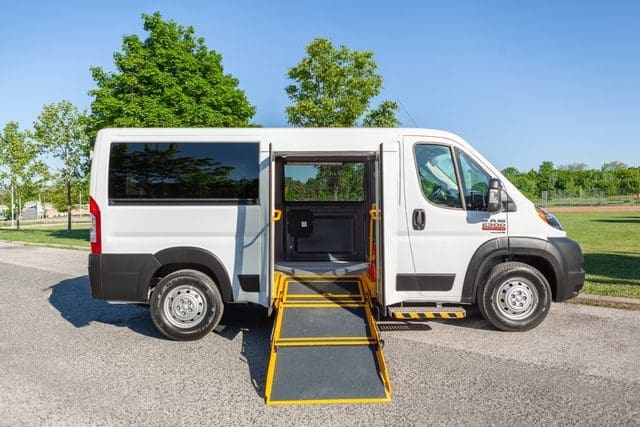
You might have landed on this article after having trouble choosing the right wheelchair accessible van.
By now, you have a better idea about the differences between these two options, along with considerations to keep in mind while choosing.
At MoveMobility, our team is all about helping you choose the right fit for your program. We’re here to lift stress off your plate, so your riders feel calm and cared for. If you have any questions or need some more guidance, don’t hesitate to click the button below to talk to a mobility expert.
Not ready to talk to someone just yet? Here are a few more articles that can guide you in the right direction:
- How to choose a wheelchair van (11 steps): Turns your shortlist into a more confident pick.
- How to compare wheelchair van quotes: This article will help steer you in the right direction when comparing different wheelchair van quotes.
- Wheelchair accessible van laws & regulations you should know about: Keeps your purchase aligned with Canadian rules and funding needs.


